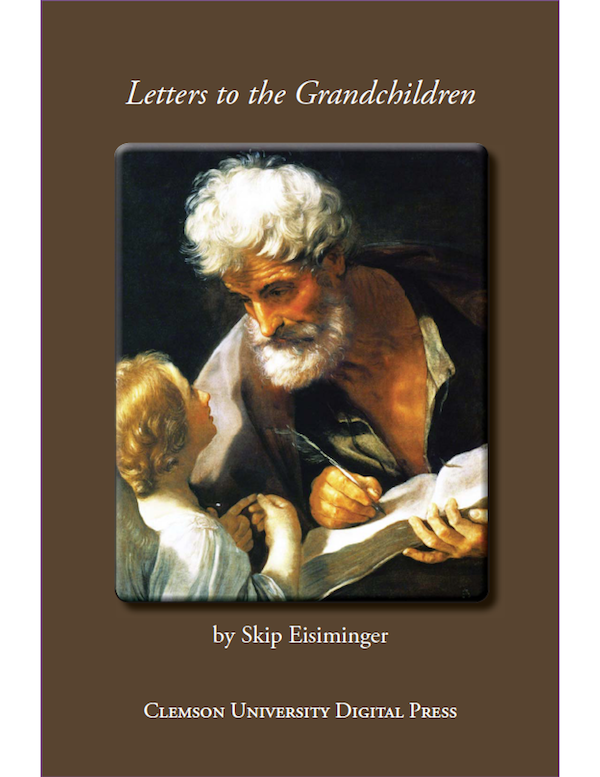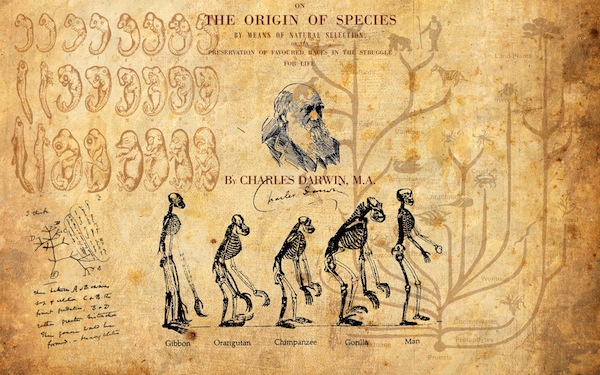“Litterae Humaniores”: “Opi” Skip’s Letters to the “Enkelkinder”
Ruminant With A View
“Arthur Schopenhauer said that given our ‘three score and ten’ allotment, a wise division would be 40 years devoted to the ‘text’ and 30 to the commentary. My division thus far has been rather less balanced—65 for the text and six for the commentary, but at least I’ve managed to get a few things in print before shuffling off to Buffalo dragging my mortal coil. To switch the metaphor, I’ve spent the last ten years unpeeling a very large onion. In the process, I’ve cut my fingers numerous times and occasionally brought tears to my eyes, but once sautéed with a little butter, the result, I think, is a palatable dish.”—By Skip Eisiminger
By Elizabeth Boleman-Herring

BRIDGE & TUNNEL New Jersey—(Weekly Hubris)—5/12/2014—Before there was Wikipedia . . . there was Skipidedia.
A peripatetic Army brat who put down a long tap root in South Carolina and, over four decades, became a beloved teacher of the Humanities (which I always capitalize: more on that anon), writing, and English literature at Clemson University, Skip Eisiminger was perhaps first and foremost a hoarder. Of words and images.
His hoard, still growing as I speak, comprises bits of writing, cartoons, and works of art copied or pasted onto 3” X 5” cards filed under some 2,200 categories, each card preserving a term, a thought, a quote, an epigram, an anecdote, an author’s insight; each, some crucial “verbal or illuminated bit coin of literary merit” that the professor-poet wished to nail down for future use in a piece of writing, a lecture, or an essay.
Skip Eisiminger is the ultimate collector of the verbal objet trouvé, and his essays, more than anything else he writes, draw for inspiration and startling diversity of thought and research on the deep well of his card file.
Of course, the file categories “Love” and “Death” have burgeoned to vast proportions, with everyone from Cicero to Bombeck weighing in, their words filed away for posterity by the Montaignesque Magpie of Strode Tower.
In 2007, just as Eisiminger was retiring from Clemson, the editor of an online journal then based in the UK and Greece approached him about writing a weekly column of his own devising and, considering his vast, yet-un-invested wealth of card-file knowledge, he proved game. That same editor/publisher eventually moved on to found Weekly Hubris, and somehow convinced Eisiminger to go on with her as he had begun. Now, Lo, four years later, he has written several hundred consistently-conceived but wildly diverse essays on topics ranging from the cartoons and quotes taped to his office door, diner slang, punning business names, musical instruments, The Trinity, fools, grandparents, and water. (And that is so bare bones skeleton a sampling of Eisiminger’s scope as a thinker and writer as to be laughable.)
In the spring of this year, Clemson University Digital Press released Letters to the Grandchildren, a selection of 46 of Eisiminger’s essays written for and originally published, largely, in Weekly Hubris. His raison for shepherding the collection into print, as opposed to settling for more ethereal publication via the web? He states: “While writing these essays, both my parents died. When I read that Cicero had left his son a series of brief personal ‘letters,’ I was disappointed that my parents had not done something similar. That’s when I decided to learn from their ‘sin’ of omission and salt away some of my essays in a book.
“Arthur Schopenhauer said that given our ‘three score and ten’ allotment, a wise division would be 40 years devoted to the ‘text’ and 30 to the commentary. My division thus far has been rather less balanced—65 for the text and six for the commentary, but at least I’ve managed to get a few things in print before shuffling off to Buffalo dragging my mortal coil. To switch the metaphor, I’ve spent the last ten years unpeeling a very large onion. In the process, I’ve cut my fingers numerous times and occasionally brought tears to my eyes, but once sautéed with a little butter, the result, I think, is a palatable dish.”
John D. Morgenstern, who has written the Foreword to this collection, more fully describes Eisiminger’s “onion” as comprising some 70,000 cards recording more than 400,000 items, all housed in five, 4’ steel cabinets, “cabinets overflowing with life.”
Morgenstern also, aptly, describes each essay as imparting a “life lesson,” though these lessons, like the professor’s famous Humanities lectures, go down painlessly and pleasurably, due to all the wit, “hard-earned wisdom,” intelligence, and raucous humor they convey along with their message. For Eisiminger, first and foremost a student of poetry, the medium is always as important as the message.
Before I yield the podium here, and re-publish, in my own space, one of my favorite Eisiminger columns, I would like to return, briefly, to the concept of the Humanities, the piebald and essential subject my friend Skip taught so well all those long decades at Clemson.
The Dictionary of Cultural Literacy tells us that the Humanities are “[o]ne of the main branches of learning,” and that “[a] scholar of the humanities studies history, literature, the fine arts, and philosophy.”
No wonder we’re all so illiterate, if that’s all E.D. Hirsch et al can say in their hubristically titled tome.
H.W. Fowler, in A Dictionary of Modern English Usage (and, if you don’t know that title, you are surely no Humanist), goes on at much greater length about humanists and the Humanities, and it is from Fowler, as well, that I take my penchant for capitalizing the discipline: “The original humanists were those who in the Dark Ages, when all learning was theology, & all the learned were priests or monks, re-discovered pre-Christian literature, turned their attention to the merely human achievements of Greek & Roman poets & philosophers & historians & orators, & so were named humanists as opposed to the divines; hence the meaning classical scholar. But this new-old learning had, or was credited with, a tendency to loosen the hold of the Church upon men’s beliefs; hence the meaning free-thinker. The third meaning—Comtist—was a new departure [as Comte founded the Religion of Humanity].”
Muses Fowler, “[The newspaper reader] occasionally realizes that [the humanist] is using the word in the sense in which he might have invented it for himself—one for whom the proper study of mankind is man, the student, & especially the kindly or humane student, of human nature.”
Nichlolas Kristof, in a recent New York Times Op/Ed column, which is so reminiscent of one of Eisiminger’s own essays, laments, vociferously and wittily, the great dumbing down of our culture, especially as regards comparative religion, this culture that has produced a Texas governor who, in speaking out against Spanish language instruction, opined, “If English was good enough for Jesus Christ, it’s good enough for us.”
Eisiminger would, post haste, scribble that quote on to a 3” X 5”, and file it under any number of topic headings.
Kristof writes: “All this goes to the larger question of the relevance of the humanities. Literature, philosophy and the arts have come to be seen as effete and irrelevant, but if we want to understand the world around us and think deeply about it, it helps to have exposure to Shakespeare and Kant, Mozart and Confucius—and, yes, Jesus, Moses and the Prophet Muhammad.”
And that’s just where professor, archivist, and purveyor of knowledge leavened with wit Skip Eisiminger comes in. He is the only writer I know who can work into one slim essay his aunt Clarice, Chuck Yeager, the data on board the Voyager spacecraft, T.S. Eliot’s paradox, quotes by Wallace Stevens and Stephen Hawking (not to speak of Ralph Waldo Emerson, Samuel Coleridge, Henry James, and Kierkegaard), but also end with an affectionate anecdote about his late German mother-in-law, and her grasp of the utterly essential, retained even during her descent into Alzheimer’s.
All that said, what comes across most fiercely and beautifully in this and other essays by Eisiminger is his own immense . . . Humanity. What a great gift it must have been to be a student in his classrooms at Clemson; what a portable, indelible gift that goes right on giving.
And I, for one, shall now begin lobbying Clemson to establish a special room in the university library devoted to the care and study of the Eisimingerian Card Catalog. For, surely, all of us deserve to be let in on this trove in its original form; not just the selected letters to the grandchildren.
Note: To order copies of Letters to the Grandchildren (Clemson University Digital Press), contact: Center for Electronic and Digital Publishing, Strode Tower, Box 340522, Clemson SC 29634-0522 (also, an order form is available online at http://www.clemson.edu/cedp/cudp).

Pack Rats & Archivists: Collecting
By Skip Eisiminger

“Personally, I favor the example set by Charles Darwin who as a boy collected specimens of the Coleopteran order. Once, with a beetle in each hand and spotting a rare example of a third, he tossed the bug clasped in one hand into his mouth and grabbed the third before it could lose itself under the leaves. That’s the unhinged spirit that keeps 175,000 museums in this country well supplied with everything from Rembrandts to barbed wire. God bless it.” By Skip Eisiminger
“Kershaw County sheriff’s deputies counted 53 cats in the refrigerator.”—AP news release
“Lord, help us keep the wolf of insignificance from our door.”—Saul Bellow
CLEMSON South Carolina—In Kurt Vonnegut’s The Sirens of Titan, the novelist describes “Skip’s Museum” as a place of “mortal remains—of endoskeletons and exoskeletons—of shells, coral, bone, cartilage, and chiton—of dottles and orts and residua of souls long gone.”
Unfortunately, Vonnegut was off the mark if he was referring to me unless he had my card file in mind because, metaphorically, I like nothing better than gathering the “residua of souls long gone.”
No, I don’t have dead cats in the refrigerator, but I have collected and classified more than 400,000 items printed in ink over the last 40 years. Simply put, the file is my first line of defense against boredom, a failing memory, and chaos. It includes quotations, cartoons, jokes, and pictures—indeed, anything written or printed that can be glued to a 3 X 5 card. It’s surprising how many “dottles and orts” can be reduced to that size, which I’m vaguely certain has something to do with the “Golden Rectangle.”
Forty years ago, I realized I was going through life as a “plankton net,” as Annie Dillard wisely recommended, but my net was so full, it was a challenge fishing out the ort I needed at any given time. Furthermore, many items were slipping through the net so, in desperation, I turned to a card-file system because some words and images are just too precious to lose.
About the time I began my file, I wrote:
“I like the quare thing that snaps the routine—
in one appendix, a sprouting bean.”
That couplet grew out of a surgeon’s story I heard on NPR. The surgeon had performed a thousand appendectomies, he said, before he stumbled on one vestigial tube off a large intestine in which a snap bean had taken root and whitely sprouted. I made a mental note, wrote it down once I reached the office, cut it out and pasted it on a card when I arrived home, and filed it under “Medicine.” To give the reader an idea of that bean’s “community,” here are a few of its neighbors:
- There’s a cartoon by J. B. Handelsman in which a doctor tells his patient, “Before we try assisted suicide . . . let’s give the aspirin a chance.” (Cross-filed under “Suicide.”)
- In 2009, robots performed over 80,000 prostatectomies. (Cross-filed under “Robots.”)
- Tobacco-smoke enemas were used as late as 1810. (Cross-filed under “Tobacco.”)
- Nazi Dr. Otto Harnish argued that naturopathy only works on Aryans. (Cross-filed under “Jews,” “Arrogance,” and “Nazis.”)
- In 2008, five times more US vets died because they lacked health care than were killed in Iraq and Afghanistan combined. (Cross-filed under “Irony.”)
- Anglican priests argued in the 19th century that women should not be given chloroform because Eve ate an apple she was told not to.(Cross-filed under “Sin,” “Obedience,”“Chauvinism,” and “Pain.”)
- And as late as 2001, the folk in Louisiana were tossing back a slug of whiskey with a fresh roach in lieu of a tetanus shot. (Cross-filed under “Folk Beliefs” and “Fools.”)
Enough about my legacy, but I come by my obsession honestly. In 1948, Dad told my Mother not to buy any more black-market clocks unless they were unlike anything she already had. She, therefore, came home from Germany with 25 unique timepieces which she hung on the den walls of several homes in succession. The ticking was enough to drive the sentient mad, but Mother loved them until she had to move them, at her expense, not the government’s. When the charm of clocks wore off, she began collecting ceramic roosters—at least they didn’t tick or crow. When she died, she left her fowl collection to my older sister who has added several more. Her daughter has promised to add some hens; thus, collections swell toward the infinite.
More than family, colleagues and friends have been the greater inspiration and justification for my collecting. My current office-mate has a house full of Big Little Books, CDs, and vintage vinyl. Another has cornered the Upstate SC market on silver fruit knives and coin changers that busmen once wore. And a former librarian has over 700 pop-up children’s books in her basement. Only adults, however, are allowed to touch them because, she ruefully admits, too often children tear out Red Riding Hood’s “basket.”
After the famed newspaper-comics collector Bill Blackbeard died in 2011, my friend with the house full of Big Little Books told me about the time he’d visited Blackbeard’s collection in San Francisco. As the harpy he was married to scolded him and his collection, Blackbeard showed his visitor to a side entrance of his modest home which led to the basement where there were piles of old newspapers and bound volumes worthy of the Collyer brothers’ apartment in Manhattan. Eventually, it would require six eighteen-wheelers to haul Blackbeard’s 75-ton collection to Ohio State University where it is now housed. Without the trace of a smile or residue of irony in his voice, my friend said he could not imagine how someone could live with that much accumulated stuff in his house. When thrift turns to hamstering, it seems, denial takes a prominent place on the collector’s shelves.
That observation was confirmed and modified on a recent trip to my father’s home in Tucson. There I met a man who told me of a big-game trophy hunter with heads of four of the five Bighorn Sheep species in North America over his mantel. Alas, four was not enough, and so he shot two Sierra Nevada Bighorns, an endangered species, in the Arizona mountains, cut off one head, left the bodies to rot, and drove to Los Angeles. Unfortunately for the hunter, he parked his car and trailer in an area under drug surveillance. The police obtained a warrant and, searching the trailer, found the sheep’s head as well as the rifle. The fellow I met did the forensics on the bullet which confirmed the poacher’s guilt. We both agreed that when collecting enters the manic phase, it richly deserves a place on the pathologist’s shelf.
Sometimes, however, it’s difficult to separate the eccentric from the pathological.
In 1876, a son in Richmond, Virginia wrote his father in Charlottesville the following, “Dear Pa, The piece I inclose [sic] is perfectly fresh and was taken from an infant’s arm yesterday . . . . Dr. Harris says the inclosed [smallpox] scab will vaccinate 12 persons but, if you want more, you must send for it. I will pin this to the letter so that you cannot lose it as you did before.” Now which collector is at fault: the careless father and his heirs who kept the attached scab without apparently using it for its intended purpose, or the Virginia Historical Society which recently placed it on public display?
Personally, I favor the example set by Charles Darwin who as a boy collected specimens of the Coleopteran order. Once, with a beetle in each hand and spotting a rare example of a third, he tossed the bug clasped in his right hand into his mouth and grabbed the third before it could lose itself under the leaves. That’s the slightly unhinged spirit that keeps 175,000 museums in this country well supplied with everything from Rembrandts to barbed wire. God bless it.



8 Comments
Wayne Mergler
Congratulations, Skip! And Elizabeth! I love you both!
Wayne M
Alan Ichiyasu
MOST EXCELLENT, #1. THERE ARE HEROES AND ALWAYS WILL BE.
THANK YOU,
THE ITCH
diana
Delightful, insightful and brilliant writing from you both.
Elizabeth Boleman-Herring
Alan and Diana, thank you . . . and I thank Skip for the collection, first, and Wayne Chapman for publishing it. Skip’s writing is a revelation, and I wish so deeply SO many more readers could know his work, and thought. At “Weekly Hubris,” we have an embarrassment of riches in the published-elsewhere collections by you, Diana, Skip, and Claire Bateman (and the performed plays of Helen Noakes; the exhibitions of Meredith d’Ambrosio and Doris Athanassakis). Just, someone, GIVE me a larger bullhorn to announce your offerings to a wider world. :-) Love, elizabeth
Skip Eisiminger
Thank you, Wayne, Itchy, Diana, and e–our day will come, but it will only last 15 minutes. For heaven’s sake, there are nigh on 7 billion of us.
Elizabeth Boleman-Herring
Thank heaven there aren’t 7 billion essayists, Skip! :-) We have a chance.
thos. burriss
funny, terrific & meaningful
like coming home
BW
Elizabeth Boleman-Herring
Thank you, Thomas! bebe